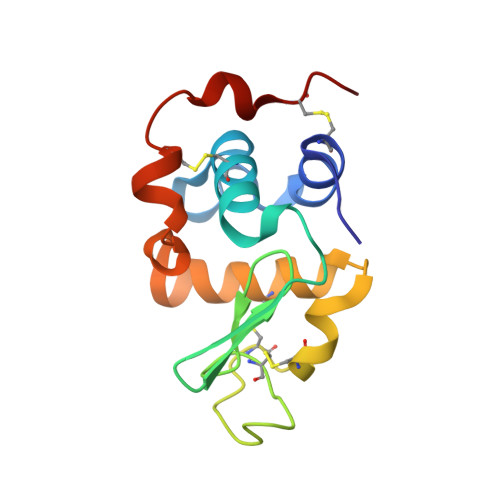ALPHA-LACTALBUMIN (LA) STIMULATES MILK BETA-1,4-GALACTOSYLTRANSFERASE I (BETA 4GAL-T1) TO TRANSFER GLUCOSE FROM UDP-GLUCOSE TO N-ACETYLGLUCOSAMINE. CRYSTAL STRUCTURE OF BETA 4GAL-T1 X LA COMPLEX WITH UDP-GLC.
Ramakrishnan, B., Shah, P.S., Qasba, P.K.(2001) J Biol Chem 276: 37665-37671
- PubMed: 11485999
- DOI: https://doi.org/10.1074/jbc.M102458200
- Primary Citation of Related Structures:
1NMM, 1NWG, 1O23 - PubMed Abstract:
beta-1,4-Galactosyltransferase 1 (Gal-T1) transfers galactose (Gal) from UDP-Gal to N-acetylglucosamine (GlcNAc), which constitutes its normal galactosyltransferase (Gal-T) activity. In the presence of alpha-lactalbumin (LA), it transfers Gal to Glc, which is its lactose synthase (LS) activity. It also transfers glucose (Glc) from UDP-Glc to GlcNAc, constituting the glucosyltransferase (Glc-T) activity, albeit at an efficiency of only 0.3-0.4% of Gal-T activity. In the present study, we show that LA increases this activity almost 30-fold. It also enhances the Glc-T activity toward various N-acyl substituted glucosamine acceptors. Steady state kinetic studies of Glc-T reaction show that the K(m) for the donor and acceptor substrates are high in the absence of LA. In the presence of LA, the K(m) for the acceptor substrate is reduced 30-fold, whereas for UDP-Glc it is reduced only 5-fold. In order to understand this property, we have determined the crystal structures of the Gal-T1.LA complex with UDP-Glc x Mn(2+) and with N-butanoyl-glucosamine (N-butanoyl-GlcN), a preferred sugar acceptor in the Glc-T activity. The crystal structures reveal that although the binding of UDP-Glc is quite similar to UDP-Gal, there are few significant differences observed in the hydrogen bonding interactions between UDP-Glc and Gal-T1. Based on the present kinetic and crystal structural studies, a possible explanation for the role of LA in the Glc-T activity has been proposed.
Organizational Affiliation:
Structural Glycobiology Section, Laboratory of Experimental and Computational Biology, Center for Cancer Research, NCI-Frederick, National Institutes of Health, Frederick, Maryland 21702, USA.

















